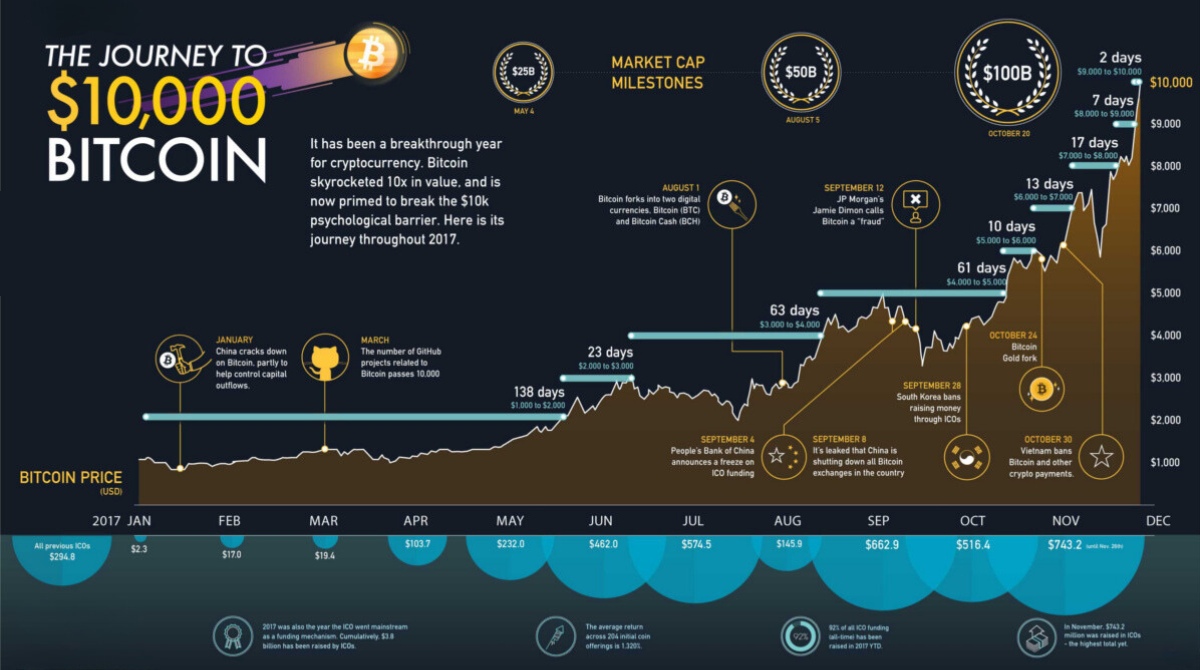Introduction
Ethereum, the second-largest cryptocurrency by market capitalization, has been generating a lot of interest and speculation in recent years. With its decentralized blockchain platform and smart contract capabilities, Ethereum has proven to be a major player in the world of cryptocurrency and blockchain technology.
The value of Ethereum is determined by a variety of factors, including market demand, technological advancements, regulatory developments, and investor sentiment. As a result, the price of Ethereum has fluctuated significantly over its relatively short lifespan.
In this article, we will explore the factors that affect Ethereum’s price, examine its current state, analyze historical price patterns, consider bullish and bearish predictions, and review expert opinions on its future trajectory. Additionally, we will explore potential catalysts that could drive Ethereum to reach the highly anticipated $10,000 mark.
It is important to note that cryptocurrency markets are highly volatile and subject to rapid and unexpected changes. Therefore, any predictions or opinions shared in this article are purely speculative and should be taken with caution.
Now, let’s dive into the factors that impact Ethereum’s price and gain a better understanding of its current state and future potential.
Factors Affecting Ethereum’s Price
The price of Ethereum is influenced by a variety of factors that can cause both short-term fluctuations and long-term trends. Understanding these factors can help investors and enthusiasts make informed decisions about buying, selling, and holding Ethereum. Here are some key factors that impact Ethereum’s price:
- Market Demand: The supply and demand dynamics of Ethereum play a crucial role in determining its price. When there is high demand for Ethereum, driven by increased adoption and usage, the price tends to rise. Conversely, a decrease in demand can lead to a drop in price.
- Technological Advancements: Ethereum’s price is affected by advancements in its underlying technology. Updates and improvements to the Ethereum blockchain, such as the implementation of Ethereum 2.0, can enhance its scalability, security, and usability, which can positively impact its price.
- Regulatory Developments: The regulatory environment surrounding cryptocurrencies can significantly impact Ethereum’s price. Positive regulatory news, such as the recognition and acceptance of Ethereum by governments and financial institutions, can boost investor confidence and drive up the price. Conversely, negative regulatory actions or uncertainties can lead to selling pressure and price declines.
- Investor Sentiment: Market sentiment and investor psychology also play a role in Ethereum’s price movements. Positive news, widespread optimism, and bullish sentiment can create buying pressure and push the price higher. On the other hand, negative news, fear, and bearish sentiment can trigger selling and result in price declines.
- Competition: Ethereum faces competition from other blockchain platforms and cryptocurrencies. If a competing platform gains significant traction or offers superior features, it can divert attention and investment away from Ethereum, potentially impacting its price.
These are just a few of the many factors that can influence Ethereum’s price. It is important to note that cryptocurrency markets are highly volatile and can be influenced by unpredictable events and market dynamics. Therefore, it is crucial to conduct thorough research and stay informed about the latest developments when analyzing Ethereum’s price movements.
Current State of Ethereum
Ethereum is currently one of the most prominent cryptocurrencies in the market, with a strong market capitalization and an active user base. As of [current date], Ethereum holds the second position in terms of market capitalization, trailing only behind Bitcoin.
One of the key factors contributing to Ethereum’s popularity is its ability to support smart contracts and decentralized applications (DApps). The Ethereum blockchain serves as a platform for developers to build and deploy DApps, which are powering a wide range of industries, including finance, gaming, and decentralized finance (DeFi).
Ethereum has also witnessed significant growth in terms of transaction volume. The number of daily transactions on the Ethereum network has been steadily increasing, reflecting the growing adoption of the platform and its use cases.
However, Ethereum has faced challenges in terms of scalability and congestion. As more users and applications join the network, the Ethereum blockchain has experienced congestion and high transaction fees. This has prompted the need for Ethereum 2.0, an upgrade that aims to address these scalability issues by transitioning to a proof-of-stake consensus mechanism and implementing shard chains.
In addition to its technical developments, Ethereum has gained recognition from institutional investors and major companies. Several well-known financial institutions have shown interest in Ethereum and have incorporated it into their investment portfolios. Furthermore, major technology companies have explored the use of Ethereum’s platform and smart contract capabilities for various applications.
Overall, the current state of Ethereum is characterized by a strong market position, growing transaction volume, and significant interest from institutional players. However, the scalability issues and the upcoming transition to Ethereum 2.0 are crucial aspects to monitor, as they will play a significant role in shaping Ethereum’s future growth and stability.
Historical Price Analysis
Ethereum has showcased remarkable price growth since its inception, with several significant milestones and volatile price swings. Let’s take a closer look at its historical price patterns to gain insights into its past performance:
In its early days, Ethereum launched with an initial price of around $0.30 per ETH token. The price remained relatively stable for the first few months before experiencing a significant surge in 2017. During the cryptocurrency bull run of that year, Ethereum reached an all-time high of over $1,400 in January 2018.
Following the peak, Ethereum, like many other cryptocurrencies, entered a prolonged bear market. The price experienced a sharp decline and settled in a range between $150 and $300 for much of 2018 and 2019. However, Ethereum started to regain momentum in early 2020 and experienced a significant price surge later in the year.
In 2020, the decentralized finance (DeFi) boom played a crucial role in driving Ethereum’s price higher. The increased usage of DeFi protocols and the demand for yield farming and liquidity mining contributed to a surge in Ethereum’s price, reaching a yearly high of around $740 in December 2020.
The year 2021 has been a historic one for Ethereum, marked by explosive growth and new all-time highs. The increasing adoption of Ethereum’s platform for various applications, including NFTs (non-fungible tokens) and decentralized exchanges, fueled its price surge. In May 2021, Ethereum reached an all-time high price of over $4,000.
Throughout its history, Ethereum’s price has shown significant volatility, with periods of rapid price appreciation and sharp corrections. This volatility is driven by various factors, including market sentiment, technological advancements, regulatory developments, and overall market trends.
It is important to note that historical price trends are not indicative of future performance. Cryptocurrency markets are highly speculative and can be influenced by numerous unpredictable factors. Therefore, conducting thorough research and analyzing current market conditions are crucial when considering investment decisions related to Ethereum.
Bullish Predictions
Many experts and analysts have expressed bullish predictions for the future price of Ethereum. Here are some of the reasons behind these optimistic forecasts:
- Continued Adoption and Use Cases: Ethereum has established itself as the leading platform for decentralized applications and smart contracts. As adoption continues to grow across industries such as finance, gaming, and decentralized finance (DeFi), the demand for Ethereum is expected to increase, potentially driving its price higher.
- Ethereum 2.0 Upgrade: The transition to Ethereum 2.0, which includes the implementation of proof-of-stake (PoS) consensus and shard chains, is anticipated to significantly improve scalability, speed, and energy efficiency. This upgrade could attract more users, boost developer participation, and positively impact the value of Ethereum.
- DeFi and NFT Expansion: The recent surge in popularity of decentralized finance (DeFi) and non-fungible tokens (NFTs) has demonstrated the potential of Ethereum’s platform. As these sectors continue to expand, the demand for Ethereum as the primary utility token and transactional currency within the ecosystem is expected to rise, potentially driving up its price.
- Institutional Adoption: The increased interest and investment from institutional players, such as financial institutions and major corporations, have provided Ethereum with added legitimacy and credibility. If this trend continues, it could lead to further adoption and potential price appreciation for Ethereum.
- Positive Market Sentiment: Overall market sentiment and favorable macroeconomic conditions can play a significant role in driving the price of cryptocurrencies. Optimism about the potential of blockchain technology, the increasing acceptance of cryptocurrencies by the general public, and a growing distrust in traditional financial systems could contribute to a bullish outlook for Ethereum.
It is important to note that these predictions are speculative and should be taken with caution. Cryptocurrency markets are known for their volatility, and various unforeseen factors can impact the price of Ethereum. As always, conducting thorough research, staying informed about the latest developments, and considering multiple perspectives are essential when evaluating future price projections for Ethereum.
Bearish Predictions
While many investors and experts are bullish on Ethereum’s future, there are also bearish predictions and concerns regarding its potential price trajectory. Here are some of the factors behind these bearish viewpoints:
- Competition from Other Platforms: Ethereum faces increasing competition from other blockchain platforms that offer similar functionalities. Scalability and fee issues on Ethereum have led to the emergence of alternative platforms that aim to address these limitations. If these platforms gain significant traction and adoption, they could draw attention and investment away from Ethereum, potentially impacting its price negatively.
- Regulatory Uncertainties: The regulatory landscape surrounding cryptocurrencies is constantly evolving and can introduce uncertainties that could negatively impact Ethereum’s price. Regulatory actions, restrictions, or unfavorable policies imposed by governments could create a bearish sentiment and hinder the growth and adoption of Ethereum.
- Scalability Challenges: Despite the planned upgrade to Ethereum 2.0, scalability issues continue to be a concern. If Ethereum is unable to effectively address its scalability challenges, such as high fees and network congestion, it may hinder adoption and limit its potential for price appreciation.
- Market Volatility: Cryptocurrency markets are notorious for their volatility, which can be driven by factors such as market sentiment, investor emotions, and external events. Rapid price fluctuations can create uncertainty and discourage potential investors, leading to a bearish outlook for Ethereum.
- Technological Risks: As with any technology, Ethereum is not immune to technical risks and vulnerabilities. Security breaches, smart contract vulnerabilities, or technological failures could erode confidence in the platform and negatively impact Ethereum’s price.
It is important to remember that bearish predictions are not guarantees of future performance, but rather potential risks and concerns to consider. While these factors may present challenges, they do not necessarily negate the long-term potential of Ethereum. It is crucial to conduct thorough research, seek diverse viewpoints, and assess various risk factors when evaluating the bearish predictions surrounding Ethereum’s price.
Experts’ Opinions
When it comes to predicting the future price of Ethereum, experts in the field have differing opinions based on their analysis and perspectives. Here are some insights from prominent individuals and institutions:
- Vitalik Buterin: As the co-founder of Ethereum, Vitalik Buterin has expressed his bullish stance on the future of Ethereum. He believes that Ethereum has the potential to become the backbone of the decentralized internet and envisions the platform expanding into various industries beyond finance.
- Anthony Pompliano: Anthony Pompliano, a well-known investor and entrepreneur, has been optimistic about Ethereum’s future. He believes that Ethereum’s role in powering decentralized finance (DeFi) and non-fungible tokens (NFTs) will contribute to its long-term growth and potentially push its price higher.
- JPMorgan: In a research note, JPMorgan analysts mentioned that Ethereum has the potential to outperform Bitcoin in the long run due to its advantages in smart contract capabilities. They praised Ethereum’s network effect and increasing adoption, highlighting the potential for its price to reach new highs.
- Coinbase: The Coinbase exchange, one of the largest cryptocurrency platforms, has listed Ethereum as a top asset and expressed bullish sentiment towards its future. They cited Ethereum’s growing ecosystem, development activity, and increasing institutional interest as factors that could contribute to its price appreciation.
- Bearish Opinions: On the other hand, some experts have expressed bearish sentiments for Ethereum. Concerns about scalability, competition from other blockchain platforms, and regulatory challenges have led to cautious predictions about its potential future price.
It is essential to note that expert opinions serve as valuable insights but should not be considered as financial advice or guarantees of future performance. The cryptocurrency market is highly speculative and influenced by various factors, making it challenging to accurately predict price movements. It is crucial to conduct thorough analysis, consider multiple perspectives, and stay updated on the latest developments when making investment decisions related to Ethereum.
Potential Catalysts
Several potential catalysts could impact the future price of Ethereum. These catalysts have the potential to drive demand, adoption, and investor sentiment. Here are some noteworthy factors that could act as catalysts for Ethereum:
- Ethereum 2.0 Upgrade: The ongoing transition to Ethereum 2.0 is a significant catalyst. The upgrade aims to address scalability issues, improve speed, and reduce transaction fees. The successful implementation of Ethereum 2.0 could attract more users, developers, and investors, leading to increased demand and potentially driving the price of Ethereum higher.
- Institutional Adoption: As more traditional financial institutions, asset managers, and corporations embrace cryptocurrencies and blockchain technology, Ethereum may experience increased institutional adoption. This adoption could lead to greater liquidity, expanded use cases, and increased investor confidence, ultimately impacting its price.
- Mainstream Integration: The integration of Ethereum into mainstream applications and industries could act as a catalyst for its price. If Ethereum’s smart contract capabilities find widespread utility and are adopted by various sectors like supply chain management, real estate, or healthcare, it could lead to increased demand for the platform and positively impact its price.
- Regulatory Clarity: Clear and favorable regulations can instill confidence in Ethereum and the broader cryptocurrency market. Positive regulatory developments, such as the recognition of cryptocurrencies as legitimate financial instruments, could stimulate investment, foster innovation, and contribute to the growth of Ethereum’s ecosystem.
- Broader Market Trends: Ethereum’s price can be influenced by broader market trends and investor sentiment towards cryptocurrencies. Positive market trends, such as increased interest in decentralization, the rise of DeFi, or a favorable macroeconomic environment, could attract more investors to Ethereum and drive its price higher.
These potential catalysts are based on current trends and projections, but their impact on Ethereum’s price is uncertain. The cryptocurrency market is highly volatile, and any speculation should be approached with caution. It is essential to monitor the market, stay informed about developments, and consider a comprehensive analysis of the various catalysts when evaluating the potential future price of Ethereum.
Conclusion
Ethereum’s price dynamics are influenced by a multitude of factors, including market demand, technological advancements, regulatory developments, and investor sentiment. While the future price of Ethereum remains uncertain, analyzing historical price patterns, considering expert opinions, and evaluating potential catalysts can provide valuable insights.
It is important to note that Ethereum’s current state reflects its position as a leading cryptocurrency with a strong market capitalization and active user base. Its underlying technology and platform for decentralized applications (DApps) continue to drive adoption and usage.
While bullish predictions highlight factors such as continued adoption, technological advancements like Ethereum 2.0, and increasing institutional interest, bearish predictions underscore potential challenges such as scalability issues, competition, and regulatory uncertainties.
It is crucial to consider the perspectives of experts and industry leaders who have varying opinions on Ethereum’s future trajectory. Factors like the success of Ethereum 2.0, institutional adoption, mainstream integration, regulatory clarity, and broader market trends have the potential to act as catalysts for Ethereum’s price movement.
However, it is essential to approach these predictions and catalysts with caution, as the cryptocurrency market is highly volatile and subject to unpredictable events. Conducting thorough research, staying informed about the latest developments, and evaluating risk factors are vital when making informed decisions related to Ethereum.
In summary, Ethereum’s future price is uncertain, and it is affected by a complex interplay of factors. By maintaining a vigilant watch on market trends, technological advancements, regulatory developments, and expert opinions, investors can navigate the ever-evolving landscape of Ethereum and the broader cryptocurrency market.

























